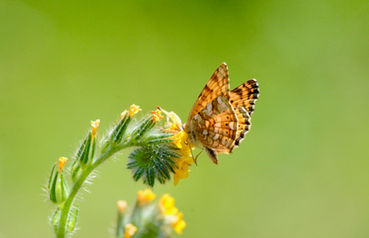Mylitta Crescent Butterfly
by Dan Sandri
These orange beauties love their jam!
April 5, 2025

Mylitta Crescent, by Dan Sandri
Are you seeing little, orange butterflies, smaller than Tortoiseshell butterflies, moving up and down the trail? They might well be Mylitta Crescents, an abundant Spring, Summer and even Fall butterfly that owes its extended seasonal success, in large part, to non-native thistles.
The Mylitta Crescent is orange, with fine to thicker black markings – they are quite variable in lightness/darkness. The tips of the clubs of their antennae are orange.
Before the import of European thistle species, Mylitta Crescent adults had a Spring season, as that is when our native Circium thistles (including C. douglasii and C. occidentale) grow. But now, when the native annual thistles dry up, the butterflies can switch over to laying eggs on non-natives like Bull Thistle (Cirsium vulgare) and others, which are able to grow through the Summer and are also found in disturbed areas (expanding Mylitta’s range too). Overall, they range from Southern British Columbia well into Mexico, and east to Eastern Colorado and Wyoming.
On Mount Diablo, the butterfly can be seen as early as late February and as late as mid-October. Male butterflies perch on the ground, or on plants, and move about searching for females near thistle plants. Females lay eggs on the underside of thistle leaves, and there can be multiple broods each year. The last generation of caterpillars will hibernate as partially-grown caterpillars. Caterpillars are black, with spines and minimal white markings.
So, when you see these little orange beauties, remember that thistles are their jam!
Explore more butterflies at our Butterfly Guide: https://www.mdia.org/butterfly-guide




